Safeguarding the Cedars of Lebanon
Air Date: Week of May 27, 2022
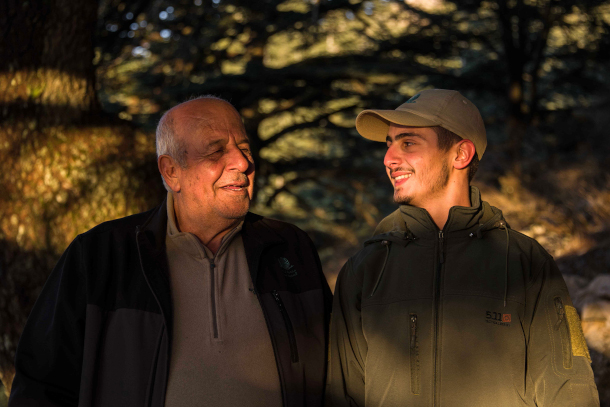
Talal Riman, pictured here with new forest guide, Farid Tarabay, 19, finally retired from his work with the cedars after almost 30 years, in September 2021, when he turned 64. (Photo: Elizabeth Fitt for Mongabay)
The Al-Shouf Biosphere Reserve is home to Lebanon’s iconic cedar forest, and even as the country faces a severe economic crisis locals are working to restore the land and practice sustainable agriculture to make a living. Elizabeth Fitt is a freelance photojournalist based in Beirut who wrote about the Shouf Reserve for Mongabay and joins Host Bobby Bascomb.
Transcript
BASCOMB:Lebanon is grappling with its worst economic crisis in decades. In the last two years the Lebanese pound has lost roughly 90% of its value, businesses are closing, and unemployment is nearly 30%. But despite the desperate times, communities near the Al-Shouf Cedar Nature Reserve are doubling down on land restoration and reforestation, sustainable agriculture and eco-tourism.
Al-Shouf is a UNESCO Biosphere Reserve, home to the country’s iconic cedar forest. The reserve is a multicultural inclusive endeavor. The majority of the population is Druze, an ethno-religious group that settled the land the middle ages. It’s also home, to Greek Orthodox Christians, Maronites, Sunni Muslim and Syrian refugees. Elizabeth Fitt is a freelance photojournalist based in Beirut. She wrote a story about the Shouf Biosphere Reserve and the community that protects it for Mongabay. Elizabeth Fitt, welcome to Living on Earth!
FITT: Hello, Bobby, thank you so much for having me.
BASCOMB: So please describe the Shouf Biosphere Reserve for someone who hasn't been there. What does it look like? And what does it feel like when you're there?
FITT: The Shouf Biosphere Reserve sounds like it's a nature reserve. But actually, it's not a nature reserve. It's more of a living laboratory for testing ways to store the landscape sustainably for the health of the environment, but also for the well-being of the 228,000 people who live within the reserve area. It's about 10 times the size of Manhattan, give or take. And it's beautiful. It's very rural. It's about 2000 meter high mountain peaks, which sort of go marching off into the distance above the lower slopes, which are covered in a patchwork of agricultural land, mostly terraces, and little villages with gorgeous old stone buildings. And just being out in the, I guess in the, in the countryside, the air feels really fresh and clean, especially in the cedar forests where it noticeably feels delicious for your lungs to breathe that air. And it's really, it's very calm and it's very quiet, but it's also very full of life.
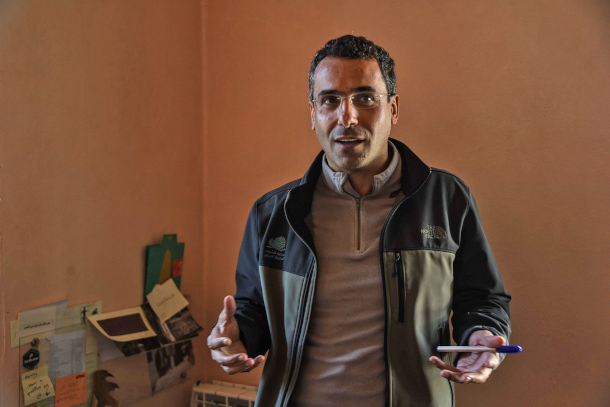
Nizar Hani, director of the Shouf Biosphere Reserve. (Photo: Elizabeth Fitt for Mongabay)
BASCOMB: Tell me please about the biodiversity of the region. You know, the unique plants and animals that live there.
FITT: Well, there are certainly a lot of plants and animals. There are 32 different mammal species, more than 275 bird species, I think something around 31 amphibian and reptile species and that includes wolves, striped hyenas, jackals, porcupines, chameleons, tortoises, badgers, eagles, snakes, storks, and I know that there's lots more that I can't remember. Oh, hyraxes, which are otherwise known as rock rabbits. There's an absolute wealth of different creatures. If you go for a walk or a drive, you can see wild flowers and herbs which are just growing by the side of the roads and across the slopes. And I don't think we had a single twilight drive back to our accommodation without seeing at least one fox or jackal. You know, butterflies and bees everywhere, I mean, it was really apparent. Actually, the director of the biosphere reserve, Nizar Hani, he was telling me that at the beginning of the project, the only wolves there were lone wolves. But nowadays, the wolves actually are operating once more in established family groups due to the biosphere’s work. Their projects have wilded some of the landscape to the point where the wolves have a safe habitat.
BASCOMB: Now Lebanon endured a really grueling Civil War from 1975 to 1990. And to some degree, that's when the Shouf Biosphere Reserve was established by a local leader named Walid Jumblatt. Can you tell us please about what he did and, and how he went about protecting the forest?
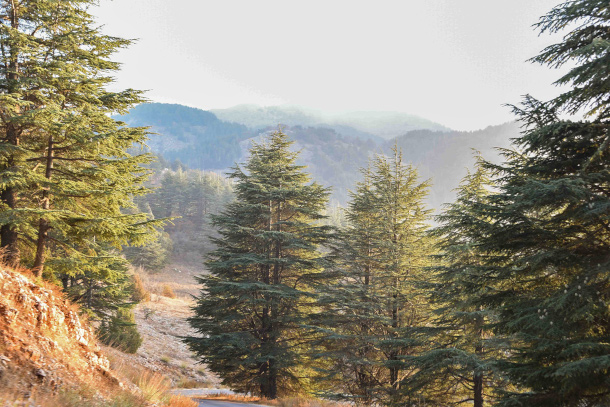
Cedars in the Barouk area of the SBR. (Photo: Elizabeth Fitt for Mongabay)
FITT: Yes. Indeed, the ecology of some parts of the area has been protected for a lot longer than the reserve has existed in its current form. Now, what you're referring to there is the cedar forest areas, which is an area of just over I think 600 hectares within the reserve, in which grow the iconic cedars of Lebanon. Those trees are revered by Lebanese culture as just being hugely, hugely important through everything from music to art to the flag of the country. So during that Civil War, Walid Jumblatt, he's a, he's a politician, and he's a local Druze leader and he did indeed take some quite extreme steps to conserve the cedar forests. He said to people, you know, stay out of the forest because people were sort of going in there willy nilly logging, smoking is a very popular habit, dropping cigarettes, starting fires. So, he tried telling people to stay out but he said that not all of them listened. So he resorted to installing landmines to protect the forest, installed land mines and then he blocked access routes to the cedar trees with earth berms and had all entrances barred using armed men and that continued for years all the way up until about 1996, I think. So I mean, a vastly different way to conserve nature there, I mean, really very different. And these days, instead of keeping people out with force, the reserve invites them in. It welcomes them as stakeholders in the natural resources of their area. Educates them on how best to manage the landscape, to the benefit of all.
BASCOMB: Can you tell us more about that? As you mentioned, I understand that they traded land mines and armed guards for tourism and sustainable harvesting. How exactly are they going about, you know, approaching conservation there today?
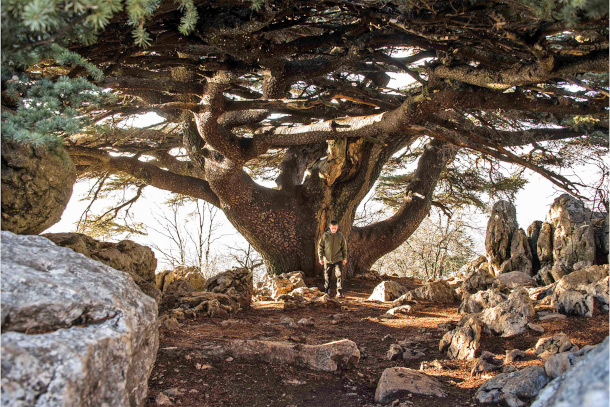
Farid Tarabay, the new forest guide, under the Lamartine Cedar, one of the oldest in the SBR. (Photo: Elizabeth Fitt for Mongabay)
FITT: So these days, the reserve seeks to involve the local community in what it does, I mean, they are a key part of that landscape. What they have done is sets up cash for training courses, where they pay people to attend training, and cash for jobs, cash for work programs. So, there you can see an immediate positive for people in the area, especially in in a country that's suffering an economic crisis, such as Lebanon as jobs are scarce. And the reserve is helping provide people with some of those jobs. But everything that this reserve does is fascinating. They seem to have managed to join the dots where each thing that they do fits into a sort of network that impacts all sorts of other things. And I'll give you an example of that. They have a fire issue in summer in there since it's dry in the summer, it's very hot and every year parts of the forest burn. And one of the things that they do is clear out biomass from the forest floor, which basically leaves any fire that does start with far less fuel, to fuel it into something that becomes uncontrollable. The biomass that they remove, just you know, branches, old wood, undergrowth, these kind of things, they shred all of that and then they mix it with pomace. And it's a byproduct of olive oil production. And turn them into what they call eco briquettes, which is like these little, little brown logs made of flammable material, which people can use to put in their stoves and to cook with. So, you've then got an actual product coming out of this environmentally friendly, job creating project, you've even then got something that is a business coming out of it as well, too. And this is particularly important in this region at this time for people to have affordable fuel, because they can't afford to heat their homes anymore, because the fuel that usually they would heat them using stoves, which have usually diesel or gasoline, those kinds of fuel prices have gone up, I think, around about 1,800% in 2001. And then since the war in Ukraine started, they've gone up a further 70%. We are out of the winter now, so people are less cold. But during the winter months, people are desperate for fuel to burn to keep their family warm and to cook with. So it's really, really important. I mean, temperatures there can get down to negative 10. I mean, it can get very, very cold, it's quite high altitude. So having this much more affordable, eco-friendly option for fuel, it's fantastic. And this year, actually there is a distributed to the most needy people. Distributed the eco-briquettes for free. And it still doesn't end there. So, the olive pomace would have been dumped into the river systems where apparently it's very acidic, and it harms the aquatic life and destroys the ecology there. So that's another knock-on effect, that's no longer happening.
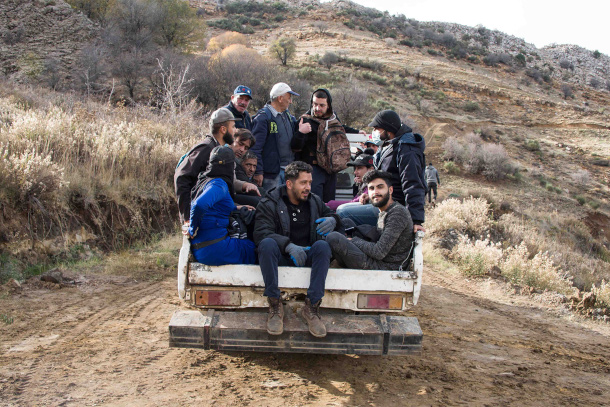
Workers heading home in the back of a truck after a day planting indigenous seedlings on an SBR reforestation project near Niha, Shouf. (Photo: Elizabeth Fitt for Mongabay)
BASCOMB: Now I've read that temperatures are rising really quickly in the area as a result of climate change. And you mentioned earlier forest fires being such a problem. How is climate change in general impacting the Shouf Biosphere Reserve?
FITT: That is absolutely true, they are rising fast. The predictions that I've seen, they are that temperatures will increase here between 1.2 and 1.7 degrees Celsius by 2050. So that's, that's a huge and quite concerning increase. So, what the reserve does is try to build the capacity of the landscape it manages to be more resilient to these changes in a number of ways, actually. But there's a lot of work going into making sure that the trees planted as part of several reforestation initiatives in the area are as genetically resilient as possible. I spoke with a man called Khaled Sleem. He's an agricultural engineer who runs a local indigenous tree nursery within the reserve and advises the reserve, as well as providing them with seedlings to plant. He has been doing that for about 17 years and he's born and bred in the reserve area. And he was telling me that all of the seedlings that the reserve uses in its reforestation projects are grown from seeds collected in the area, rather than from seeds from elsewhere, and rather than from cloned cuttings. Now he said, that's an effort to ensure maximum genetic diversity and that is what he hopes will result in trees with a greater chance of surviving longer as climate change bites. And he's developed also a special root air pruning pot, which he plants the seeds in there, and the seedlings begin in these in these funny looking little black pots with grooves down the sides. Which as the roots grow it trains the roots in a certain direction and then exposes them to the air. So the roots are carefully trained before the seedlings are planted out into the wild to have really strong root networks by this air pruning. And I mean, this is really working very well for them so far, because the seedling survival rates since they have turned to root air pruning has increased from 15% survival only to over 90%. So that's hope that the resilience of those root systems will help these little trees grow through a period of warming, more resiliently than they otherwise would.
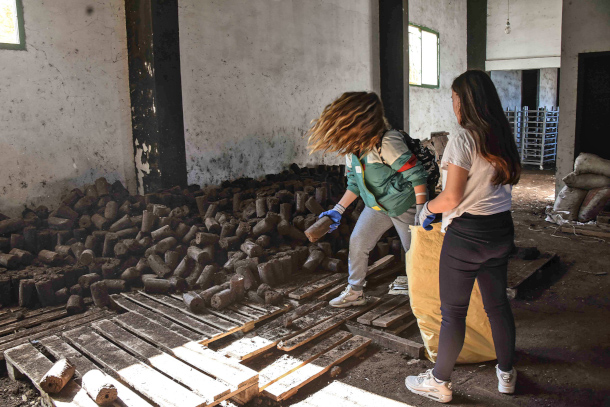
Young adults pack eco-briquettes while learning about sustainable restoration techniques on a Lebanese Reforestation Initiative SBR program. (Photo: Elizabeth Fitt for Mongabay)
BASCOMB: Well, that's amazing. They've really thought this through.
FITT: Yeah, and one other thing that really struck me, I think the second reason there may have been less plundering of local natural resources in these very tough times, and I really felt the impact of this during my visits, everyone and I mean, everyone I met, from shopkeepers, to hikers, to shepherds, to university students, really people totally unaffiliated with the reserve, just that I met on the street, they knew about the reserve, they were able to discuss how it's helping the region, and were unanimously enthusiastic about it. And it was actually really inspiring to see that level of local buy in. And I would say a good indicator that the methods being tested here they're working. I don't think you'd see that level of positivity if there weren't some proof to the pudding.
BASCOMB: Elizabeth Fitt is a freelance journalist and photographer currently based in Beirut, she wrote about the Shouf Biosphere Reserve for Mongabay. Elizabeth, thank you so much for your time.
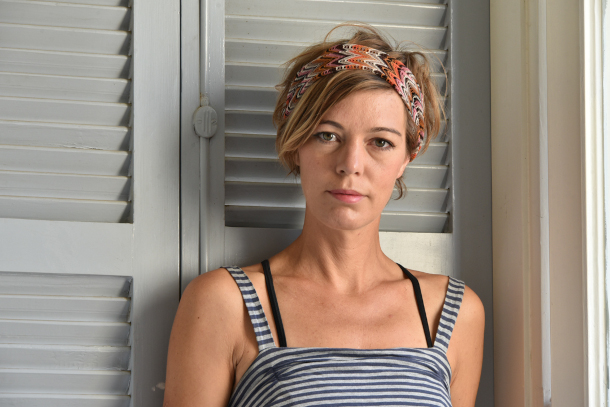
Elizabeth Fitt is a freelance journalist and photographer currently based out of Beirut, Lebanon. (Photo: Courtesy of Elizabeth Fitt)
FITT: You're very, very welcome. Thank you for having me.
Links
Learn more about the Shouf Biosphere Reserve
Follow Elizabeth Fitt via Instagram @elizabethfittphotography
Living on Earth wants to hear from you!
Living on Earth
62 Calef Highway, Suite 212
Lee, NH 03861
Telephone: 617-287-4121
E-mail: comments@loe.org
Newsletter [Click here]
Donate to Living on Earth!
Living on Earth is an independent media program and relies entirely on contributions from listeners and institutions supporting public service. Please donate now to preserve an independent environmental voice.
NewsletterLiving on Earth offers a weekly delivery of the show's rundown to your mailbox. Sign up for our newsletter today!
 Sailors For The Sea: Be the change you want to sea.
Sailors For The Sea: Be the change you want to sea.
 The Grantham Foundation for the Protection of the Environment: Committed to protecting and improving the health of the global environment.
The Grantham Foundation for the Protection of the Environment: Committed to protecting and improving the health of the global environment.
 Contribute to Living on Earth and receive, as our gift to you, an archival print of one of Mark Seth Lender's extraordinary wildlife photographs. Follow the link to see Mark's current collection of photographs.
Contribute to Living on Earth and receive, as our gift to you, an archival print of one of Mark Seth Lender's extraordinary wildlife photographs. Follow the link to see Mark's current collection of photographs.
 Buy a signed copy of Mark Seth Lender's book Smeagull the Seagull & support Living on Earth
Buy a signed copy of Mark Seth Lender's book Smeagull the Seagull & support Living on Earth

